Standard Paint Can Sizes with Size Chart
You planned a home improvement project after watching a marathon of Youtube videos. Everything was fine until you were standing in front of an old, stained, blank wall and had no idea how much paint ... Read more The post Standard Paint Can Sizes with Size Chart appeared first on Arthitectural.
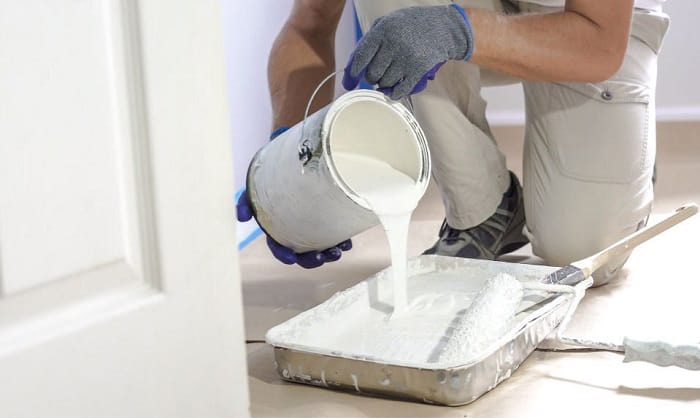

You planned a home improvement project after watching a marathon of Youtube videos. Everything was fine until you were standing in front of an old, stained, blank wall and had no idea how much paint you needed to cover this entire area. A big tub or a slightly smaller one?
Then you start to wonder: what are the standard paint can sizes? You head to Lowe’s and find yourself lost amid all of these walls of paint cans.
Here’s the paint can size chart and how to easily figure out the perfect size for your project. Read on!
What Sizes Does Paint Come in?
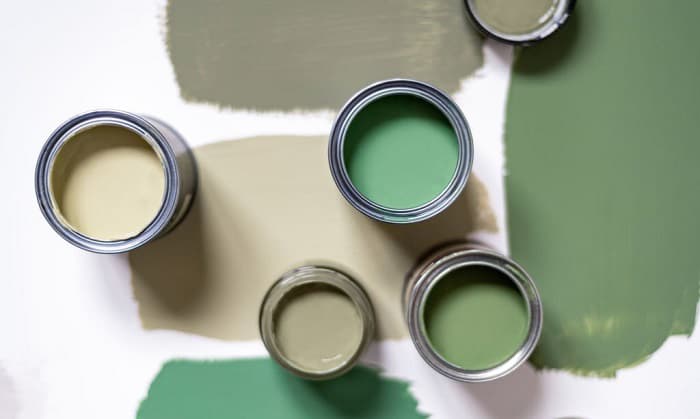
Paint cans come in a variety of sizes. However, there are some standard dimensions so that you won’t get lost in a matrix of sizes of paint cans.
The most common ones you typically find at your local stores are:
- One-pint cans
- One-quart cans
- One-gallon cans
It also comes in intermediate sizes, including:
- Half-pints
- Half-gallons
- Five-quarts
But you can still get five-gallon buckets for massive renovation projects or a quarter-pint to try out the color and how it coordinates with your idea in reality.
Paint cans usually have uniform measurements according to the industry standard.
- A one-gallon can is 7.5″ in height and 6.5″ in diameter
- A one-quart can is 4 ⅞” in height and 4.25″ in diameter
- A one-pint can is 3 15/16″ in height and 3 7/16″ in diameter
Sometimes there are odd-sized paint cans, so you should always check the capacity for checking out.
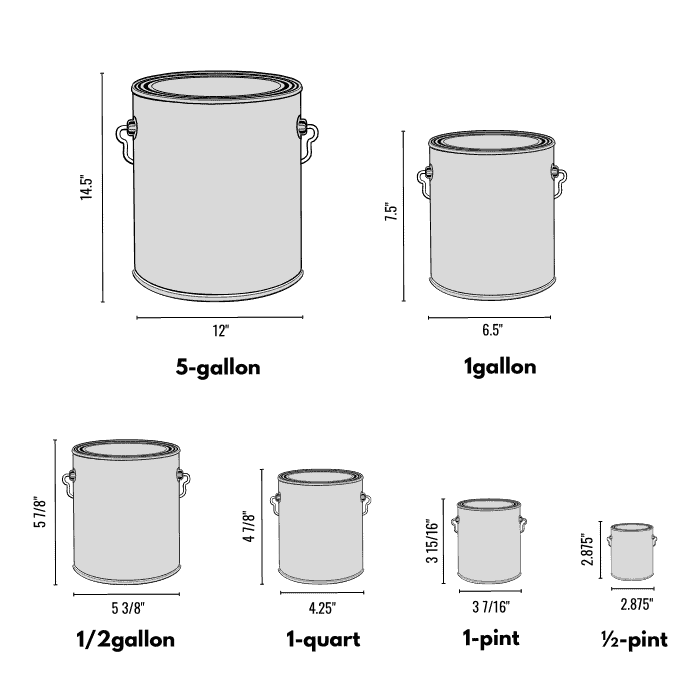
|
Paint can size |
Fill capacity | Dimension | ||
| In fluid ounces | In liters | Diameter | Height | |
| ¼-pint | 4 | 0.12 | 2 ½” | 2 1/16” |
| ½-pint | 8 | 0.24 | 2 7/8” | 2 7/8” |
| 1-pint | 16 | 0.47 | 3 7/16” | 3 15/16” |
| 1-quart | 32 | 0.95 | 4 ¼” | 4 ⅞” |
| ½-gallon | 64 | 1.89 | 5 ⅜” | 5 ⅞” |
| 1-gallon | 128 | 3.79 | 6 ½” | 7 ½” |
| 5-quart | 190 | 4.73 | 6 ⅝” | 9 ½” |
| 5-gallon | 640 | 18.93 | 12” | 14 ½” |
Knowing paint can dimensions and choosing the right combination of sizes can help you get down to the precise amount of paint you need. Here we give you a 3-step instruction so that you won’t waste your money with an excessive amount of pain or won’t have to pay multiple trips to the store.
Step 1: Calculate the paint area
The simplest formula is to take the wall area minus surfaces that you don’t want to paint: wall area – door/window area.
Now let’s add an example: Your master bedroom is 15 x 20 feet with a standard 8-foot ceiling. It has a double door and 2 windows.
- Calculate the room’s perimeter: (15 ft. + 20 ft.) x 2= 70 ft.
- Calculate the total wall area: 70 ft x 8 ft = 560 sq. ft.
- Minus the area of the door and windows (standard doors are usually 21 square feet and windows are 15 square feet) = 560 sq. ft. – (21 sq. ft. x 2) – (15 sq. ft. x 2) = 488 sq. ft.
*The door is a double door, so it counts as two.
So now you know you need to cover an area of 488 square feet.
Of course, if you have weirdly-shaped doors and windows at home, you will need to make some adjustments here.
Step 2: Determine the perfect paint can size.
The rule of thumb is:
- One pint of paint covers about 50 square feet
- One quart of paint covers about 100 square feet
- One gallon of paint covers about 350-400 square feet
So, with your 488-square-feet master bedroom, you would likely need 1.5 gallons, which can come down to one 1-gallon can and one ½-gallon can.
If this is your first time painting, you can get just a tiny bit more to be on the safe side.
If you’re just like us, you want nothing to do with math, then here’s the paint can size chart to help you determine how much paint you need for a given area.
Also, please be aware that this chart does not take into account windows and doors. So if your house is in the Circus in Bath, England, you might need to take this chart with a grain of salt.
Paint can size chart (with a standard 8-feet ceiling)
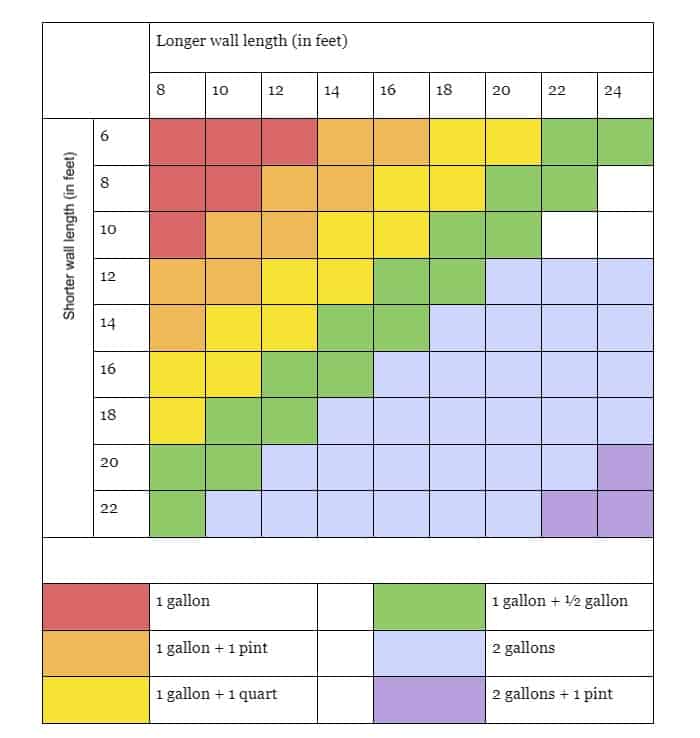
So looking at this color chart, taking the previous example, you will end up in a green cell, which means you will need 1.5 gallons of paint.
If you have a tiny single bedroom that is 8 x 8 feet, you will need a gallon of paint and so on. It’s so much easier, right?
If your room is 30 x 60 feet, we don’t think you need to do the calculation and painting yourself. You might already have a fleet of painters and constructors ready to do the job.
Step 3: Consider additional factors
The calculation and the chart will only give you a general idea of how much you will need. Still, when it comes down to reality, the exact amount will vary depending on some variables.
- The first one to consider is the current color of the wall.
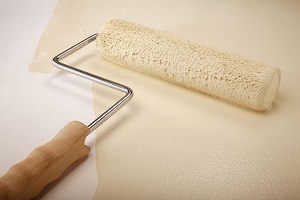
If your walls are navy blue now and you want to brighten your room, let’s say, with beige. You might consider doing multiple coats of paint, probably more than two, and of course, this would change your calculation.
- The second one is the surface texture and porosity.
The smoother the texture, the less paint you will need. Following the same vein, the less porous the wall, the less paint you will need.
Textured walls are a monster when it comes to painting. They have bumps, ridges, and not to mention intentional texture design that absorbs more paint and absorbs it unevenly, which result in blotches and uneven color.
- The third one is whether your wall is primed or not. An unprimed wall absorbs paint more than a primed one.
- And fourth, definitely not the last, is the type of paint.
It does matter when you buy a $200 paint can or a $2 acrylic paint from the Dollar Store. If you opt for the more affordable option, do expect to buy a bit more paint because of its relatively low coverage.
Also, is it a primer or a finishing paint? For primers, it requires less paint to obtain the same opacity as the finishing paint. Usually, a gallon of primer can cover 200-300 square feet. Now apply the formula above to find out the amount you need.
A super tip for you now that you are here: online paint calculators are available! Big hardware stores and some paint companies offer their customers this magic tool.
You only need to fill in the measurements, and it will immediately tell you how much paint you need and maybe how long it takes to finish painting.
Conclusion
We know it is such a bummer when we are so hyped about our home improvement projects and get immediately turned off because of a paint can and a small miscalculation. Hopefully, with this chart of the standard paint can sizes, you can plan better.
If you find your answer from this article, please share it with the people still getting lost at Home Depot’s paint department. Thank you for reading! Until next time!
The post Standard Paint Can Sizes with Size Chart appeared first on Arthitectural.
